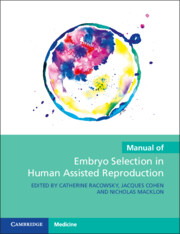Book contents
- Manual of Embryo Selection in Human Assisted Reproduction
- Manual of Embryo Selection in Human Assisted Reproduction
- Copyright page
- Contents
- Contributors
- Preface
- Chapter 1 Introduction
- Chapter 2 Embryo Developmental Programming
- Chapter 3 Embryo–Maternal Interactions
- Chapter 4 The Sperm’s Role in Embryo Development
- Chapter 5 The Oocyte’s Role in Embryo Development
- Chapter 6 The Laboratory’s Role in Embryo Development
- Chapter 7 Handling of Gametes and Embryos
- Chapter 8 Noninvasive Morphological Selection of Oocytes
- Chapter 9 Prospects for Bioenergetics for Embryo Selection
- Chapter 10 Static Morphological Assessment for Embryo Selection
- Chapter 11 Dynamic Morphological Assessment for Embryo Selection
- Chapter 12 Noninvasive Analysis of Embryo Nutrient Utilization for Embryo Selection
- Chapter 13 Genomics for Embryo Selection
- Chapter 14 Biopsy Techniques from Polar Body to Blastocyst
- Chapter 15 Cell-Free DNA Analysis for PGT-A
- Chapter 16 What Science May Come for Embryo Selection?
- Epilogue
- Index
- References
Chapter 10 - Static Morphological Assessment for Embryo Selection
Published online by Cambridge University Press: 26 April 2023
- Manual of Embryo Selection in Human Assisted Reproduction
- Manual of Embryo Selection in Human Assisted Reproduction
- Copyright page
- Contents
- Contributors
- Preface
- Chapter 1 Introduction
- Chapter 2 Embryo Developmental Programming
- Chapter 3 Embryo–Maternal Interactions
- Chapter 4 The Sperm’s Role in Embryo Development
- Chapter 5 The Oocyte’s Role in Embryo Development
- Chapter 6 The Laboratory’s Role in Embryo Development
- Chapter 7 Handling of Gametes and Embryos
- Chapter 8 Noninvasive Morphological Selection of Oocytes
- Chapter 9 Prospects for Bioenergetics for Embryo Selection
- Chapter 10 Static Morphological Assessment for Embryo Selection
- Chapter 11 Dynamic Morphological Assessment for Embryo Selection
- Chapter 12 Noninvasive Analysis of Embryo Nutrient Utilization for Embryo Selection
- Chapter 13 Genomics for Embryo Selection
- Chapter 14 Biopsy Techniques from Polar Body to Blastocyst
- Chapter 15 Cell-Free DNA Analysis for PGT-A
- Chapter 16 What Science May Come for Embryo Selection?
- Epilogue
- Index
- References
Summary
This chapter evaluates the relevance of static evaluations for the morphological assessment of human embryos at each developmental milestone during the preimplantation period. The value of pronuclei scoring, including consideration of the number and disposition of nucleoli, as well as the presence of the cytoplasmic halo is described. Focused attention is given to the cleavage stage with respect to the stage-appropriateness of the number and size of the cells, and the extent of cytoplasmic fragmentation. Consideration is given to the timing and degree of compaction as the morula develops, and the quality of the blastocyst regarding its extent of expansion and the priority that should be given to trophectoderm quality over that of the inner cell mass. It is concluded that although static assessment at each stage of development may provide small stage-specific increments of benefit to identifying the most viable embryo in a cohort, available evidence does not support such cumulative static scoring and there are potential risks to this approach due to disturbance of the culture environment each time the embryo is removed from the incubator.
- Type
- Chapter
- Information
- Manual of Embryo Selection in Human Assisted Reproduction , pp. 100 - 112Publisher: Cambridge University PressPrint publication year: 2023



